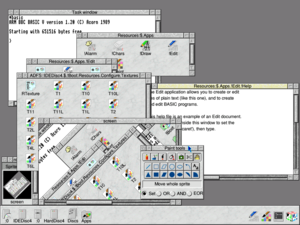
Back RISC OS Catalan RISC OS Czech RISC OS Welsh RISC OS German RISC OS Spanish RISC OS Estonian RISC OS Finnish RISC OS French RISC OS Croatian RISC OS Italian
 RISC OS cogwheel logo | |
 A screenshot of RISC OS 4 | |
| Developer | Acorn Computers
Open-source (version 5) Proprietary (versions 4 & 6) |
|---|---|
| Written in | BBC BASIC, C, C++, assembly language |
| Working state | Current |
| Source model | Closed source; open source for some versions since 2018 |
| Initial release | 25 September 1987[1] |
| Latest release |
|
| Latest preview | 5.31 |
| Marketing target | Acorn personal computers |
| Available in | English |
| Update method | Flash ROM, OTP ROM, or loadable ROM image |
| Package manager | PackMan, RiscPkg |
| Platforms | ARM |
| Kernel type | Monolithic |
| Default user interface | GUI |
| License |
|
| Preceded by | MOS ARX (discontinued) |
| Official website | riscosopen riscos |
RISC OS (/rɪsk.oʊˈɛs/)[4] is a computer operating system originally designed by Acorn Computers Ltd in Cambridge, England. First released in 1987, it was designed to run on the ARM chipset, which Acorn had designed concurrently for use in its new line of Archimedes personal computers. RISC OS takes its name from the reduced instruction set computer (RISC) architecture it supports.
Between 1987 and 1998, RISC OS was included in every ARM-based Acorn computer model, including the Acorn Archimedes line, Acorn's R line (with RISC iX as a dual-boot option), RiscPC, A7000, and prototype models such as the Acorn NewsPad and Phoebe computer. A version of the OS, named NCOS, was used in Oracle Corporation's Network Computer and compatible systems.
After the break-up of Acorn in 1998, development of the OS was forked and continued separately by several companies, including RISCOS Ltd, Pace Micro Technology, Castle Technology, and RISC OS Developments.[5] Since then, it has been bundled with several ARM-based desktop computers such as the Iyonix PC[6] and A9home. As of March 2017[update], the OS remains forked and is independently developed by RISCOS Ltd and the RISC OS Open community.
Most recent stable versions run on the ARMv3/ARMv4 RiscPC, the ARMv5 Iyonix,[7] ARMv7 Cortex-A8 processors[8][9] (such as that used in the BeagleBoard and Touch Book) and Cortex-A9 processors[10] (such as that used in the PandaBoard) and the low-cost educational Raspberry Pi computer.[11][12][13] SD card images have been released for downloading free of charge to Raspberry Pi 1, 2, 3, & 4 users with a full graphical user interface (GUI) version[14] and a command-line interface only version (RISC OS Pico, at 3.8 MB).[15]
- ^ copyright notice Arthur 1.20 (25 September 1987)
- ^ Revill, Steve (27 April 2024). "RISC OS 5.30 now available". RISC OS Open. Retrieved 30 April 2024.
- ^ RISC OS is open for business! Archived 22 October 2018 at the Wayback Machine, RISC OS Open Ltd, accessed 2018-10-23
- ^ "RISC OS" (PDF). ISV Department news from Acorn. No. 14. Acorn Computers Limited. May 1989. p. 2. Archived (PDF) from the original on 21 May 2021. Retrieved 14 February 2021.
It is RISC OS (pronounced risk oh ess, not risk oss)
- ^ Cite error: The named reference
riscosdevwas invoked but never defined (see the help page). - ^ "Acorn announces distribution deal with Castle Technology for RISC based products" (Press release). Acorn Computers Ltd. 12 October 1998. Archived from the original on 6 May 1999. Retrieved 6 January 2011.
(October 12th 1998), Cambridge, UK-Acorn announced today that it has completed negotiations with Castle Technology for them to distribute Acorn products.
- ^ "RISC OS 5 features". Iyonix Ltd. Archived from the original on 10 November 2010. Retrieved 31 January 2011.
All IYONIX pcs ship with RISC OS 5 in flash ROM.
- ^ Farrell, Nick (27 April 2009). "Snaps leak of RISC OS5 on BeagleBoard". The Inquirer. Archived from the original on 19 May 2009. Retrieved 28 June 2011.
A snap of an RISC OS 5, running on a BeagleBoard device powered by a 600MHz ARM Cortex-A8 processor with a built-in graphics chip, has tipped up on the world wide wibble. The port developed by Jeffrey Lee is a breakthrough for the shared-source project because it has ported the OS without an army of engineers.
{{cite web}}: CS1 maint: unfit URL (link) - ^ "Cortex-A8 port status". RISC OS Open. Archived from the original on 26 October 2021. Retrieved 31 January 2011.
[The port includes] a modified version of the RISC OS kernel containing support for (all) Cortex-A8 CPU cores.
- ^ Revill, Steve (25 April 2015). "RISC OS 5.22 stable is now available". RISC OS Open. Retrieved 25 April 2015.
- ^ Lee, Jeffrey. "Newsround". The Icon Bar. Archived from the original on 4 January 2016. Retrieved 17 October 2011.
- ^ Holwerda, Thom (31 October 2011). "Raspberry Pi To Embrace RISC OS". OSNews. Archived from the original on 4 January 2016. Retrieved 1 November 2011.
- ^ Dewhurst, Christopher (December 2011). "The London show 2011". Archive. Vol. 23, no. 3. p. 3.
- ^ "Downloads". Raspberry Pi. Archived from the original on 14 January 2013. Retrieved 2 September 2013.
- ^ "RISC OS Open: Raspberry Pi". riscosopen.org. Archived from the original on 20 March 2021. Retrieved 25 April 2015.